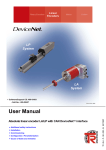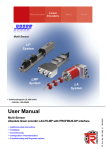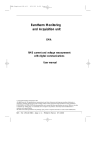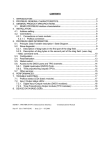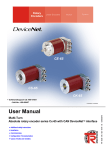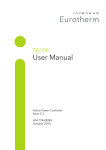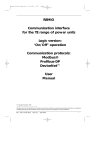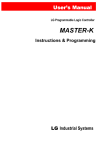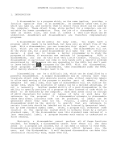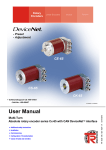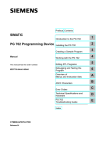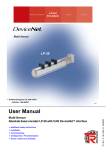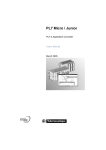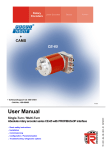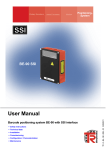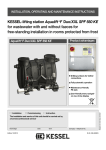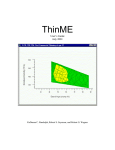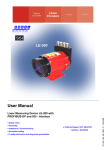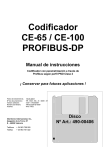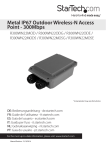Download User Manual - TR Electronic
Transcript
Rotary Encoders Linear Encoders Motion System LP System LMP System LA System • Software/Support CD: 490-01001 - Soft-No.: 490-00406 • Additional safety instructions • Installation • Commissioning • Configuration / Parameterization • Troubleshooting and Diagnostic options TR - ELA - BA - GB - 0001 - 05 Absolute linear encoder LA/LP/LMP with PROFIBUS-DP interface 08/08/2007 User Manual TR-Electronic GmbH D-78647 Trossingen Eglishalde 6 Tel.: (0049) 07425/228-0 Fax: (0049) 07425/228-33 E-mail: [email protected] http://www.tr-electronic.de Copyright protection This Manual, including the illustrations contained therein, is subject to copyright protection. Use of this Manual by third parties in contravention of copyright regulations is forbidden. Reproduction, translation as well as electronic and photographic archiving and modification require the written content of the manufacturer. Offenders will be liable for damages. Subject to amendments Any technical changes that serve the purpose of technical progress, reserved. Document information Release date/Rev. date: Document rev. no.: File name: Author: 08/08/2007 TR - ELA - BA - GB - 0001 - 05 TR-ELA-BA-GB-0001-05.DOC MÜJ Font styles Italic or bold font styles are used for the title of a document or are used for highlighting. Courier font displays text, which is visible on the display or screen and software menu selections. ″< > ″ indicates keys on your computer keyboard (such as <RETURN>). Trademarks SIMATIC S5, STEP-5 and COM-ET-200 are registered trademarks of SIEMENS AG. PROFIBUS-DP and the PROFIBUS logo are registered trademarks of the Profibus User Organisation (PNO) © TR-Electronic GmbH 2007, All Rights Reserved Page 2 of 50 Printed in the Federal Republic of Germany TR - ELA - BA - GB - 0001 - 05 08/08/2007 Contents Contents Contents .............................................................................................................................................. 3 Revision index .................................................................................................................................... 5 1 General information ........................................................................................................................ 6 1.1 Applicability ............................................................................................................................. 6 1.2 Abbreviations used / Terminology .......................................................................................... 7 2 Additional safety instructions........................................................................................................ 8 2.1 Definition of symbols and instructions .................................................................................... 8 2.2 Additional instructions for proper use ..................................................................................... 8 2.3 Organizational measures........................................................................................................ 9 3 Technical data.................................................................................................................................. 10 3.1 Electrical characteristics ......................................................................................................... 10 4 Interface information’s.................................................................................................................... 11 4.1 PROFIBUS.............................................................................................................................. 11 4.1.1 DP Communication protocol ................................................................................... 11 5 Installation / Preparation for commissioning ............................................................................... 12 5.1 PROFIBUS – interface............................................................................................................ 12 5.1.1 RS485 Data transmission technology .................................................................... 12 5.1.2 Bus termination ....................................................................................................... 13 5.1.3 Bus address ............................................................................................................ 13 5.2 Shield cover ............................................................................................................................ 14 6 Commissioning................................................................................................................................ 16 6.1 Requirements for start-up on IM-308-C.................................................................................. 16 6.2 Requirements for start-up on SIMATIC-S7 ............................................................................ 16 6.3 Device Master File (GSD), Type file ....................................................................................... 17 6.4 PNO ID number ...................................................................................................................... 17 6.5 Starting up on the PROFIBUS ................................................................................................ 18 6.6 Bus status display................................................................................................................... 19 7 Parameterization and configuration .............................................................................................. 20 7.1 Overview ................................................................................................................................. 21 7.2 PNO CLASS 1 16 bits........................................................................................................... 22 7.3 PNO CLASS 1 32 bits........................................................................................................... 23 7.4 PNO CLASS 2 16 bits........................................................................................................... 24 7.5 PNO CLASS 2 32 bits........................................................................................................... 26 © TR-Electronic GmbH 2007, All Rights Reserved Printed in the Federal Republic of Germany 08/08/2007 TR - ELA - BA - GB - 0001 - 05 Page 3 of 50 Contents 7.6 TR-extended 32 Bit................................................................................................................. 28 7.7 TR-extended + Speed 32 Bit .................................................................................................. 31 7.8 Preset adjustment function ..................................................................................................... 34 7.9 Description of the operating parameters ................................................................................ 35 7.9.1 Code sequence....................................................................................................... 35 7.9.2 Class 2 Functionality............................................................................................... 35 7.9.3 Diagnostic alarm ..................................................................................................... 35 7.9.4 Scaling function....................................................................................................... 35 7.9.5 Total measuring range, hi/lo ................................................................................... 36 7.9.6 Preset 1 value, hi/lo ................................................................................................ 36 7.9.7 Speed resolution, 0.1mm/s ..................................................................................... 37 7.9.8 Input of parameters with data format 32 bits .......................................................... 37 7.10 Configuration example, SIMATIC® Manager V5.3 ............................................................... 38 8 Troubleshooting and diagnosis options....................................................................................... 42 8.1 Optical displays, LEDs............................................................................................................ 42 8.2 Use of the PROFIBUS diagnosis............................................................................................ 43 8.2.1 Standard diagnosis ................................................................................................. 43 8.2.1.1 Station status 1................................................................................................................................ 44 8.2.1.2 Station status 2................................................................................................................................ 44 8.2.1.3 Station status 3................................................................................................................................ 44 8.2.1.4 Master address................................................................................................................................ 45 8.2.1.5 Manufacturer's identifier .................................................................................................................. 45 8.2.1.6 Length (in bytes) of the extended diagnosis.................................................................................... 45 8.2.2 Extended diagnosis................................................................................................. 46 8.2.2.1 Alarms ............................................................................................................................................. 46 8.2.2.2 Operating status .............................................................................................................................. 47 8.2.2.3 Encoder type ................................................................................................................................... 47 8.2.2.4 Measuring step ................................................................................................................................ 47 8.2.2.5 Number of resolvable revolutions .................................................................................................... 47 8.2.2.6 Additional alarms ............................................................................................................................. 47 8.2.2.7 Alarms supported ............................................................................................................................ 48 8.2.2.8 Warnings ......................................................................................................................................... 48 8.2.2.9 Warnings supported ........................................................................................................................ 48 8.2.2.10 Profile version................................................................................................................................ 48 8.2.2.11 Software version............................................................................................................................ 49 8.2.2.12 Operating hours counter................................................................................................................ 49 8.2.2.13 Offset value ................................................................................................................................... 49 8.2.2.14 Manufacturer's offset value............................................................................................................ 49 8.2.2.15 Number of steps per revolution ..................................................................................................... 49 8.2.2.16 Total measuring range................................................................................................................... 49 8.2.2.17 Serial number ................................................................................................................................ 49 8.2.2.18 Manufacturer's diagnoses.............................................................................................................. 50 8.3 Other faults ............................................................................................................................. 50 Appendix Pin assignment LA-66, 8-pol. MINI-COMBICON – Connector, Preset ......................... TR-ELA-TI-GB-0005 LA-66, 5 x 2-pol. Screw terminal, Preset ............................................. TR-ELA-TI-GB-0024 LA-66, 5 x 2-pol. Screw terminal, 3 x M12.........................................TR-ELA-TI-DGB-0047 LP-38.................................................................................................... TR-ELA-TI-GB-0025 LA-46 / LP-46, Cable screw glands ..................................................... TR-ELA-TI-GB-0044 LA-46 / LP-46, 2 x M12, 1 x M8 .........................................................TR-ELA-TI-DGB-0051 LMP-30, 3 x M12................................................................................TR-ELA-TI-DGB-0055 LMP-30, Cable screw glands.............................................................TR-ELA-TI-DGB-0060 LMP-30, 2 x M12, 1 x M8...................................................................TR-ELA-TI-DGB-0061 © TR-Electronic GmbH 2007, All Rights Reserved Page 4 of 50 Printed in the Federal Republic of Germany TR - ELA - BA - GB - 0001 - 05 08/08/2007 Revision index Revision index Revision Date Index First release 07/16/97 00 Operating manual added with LP-38. Pin assignment appended separately. 12/09/98 01 Expansion of the parameterization function with the parameter "Diagnostic 01/18/01 alarm" 02 Modification of the device- and type-file designations, which were already 06/11/02 created quite a long time ago (05/06/99). 03 New GSD-file "TR03AAAC.GSD" / 02/17/05, useable for linear-encoder with 03/01/05 speed-output 04 General technical modifications, layout modifications 05 © TR-Electronic GmbH 2007, All Rights Reserved Printed in the Federal Republic of Germany 08/08/2007 08/08/07 TR - ELA - BA - GB - 0001 - 05 Page 5 of 50 General information 1 General information This interface-specific User Manual includes the following topics: • Safety instructions in additional to the basic safety instructions defined in the Assembly Instructions • Electrical characteristics • Installation • Commissioning • Configuration / parameterization • Troubleshooting and diagnostic options As the documentation is arranged in a modular structure, this User Manual is supplementary to other documentation, such as product datasheets, dimensional drawings, leaflets and the assembly instructions etc. The User Manual may be included in the customer's specific delivery package or it may be requested separately. 1.1 Applicability This User Manual applies exclusively to the following measuring system models with PROFIBUS-DP interface: • • • LA LP LMP The products are labelled with affixed nameplates and are components of a system. The following documentation therefore also applies: • • • the operator's operating instructions specific to the system, this User Manual, and the assembly instructions TR-ELA-BA-DGB-0004, which is enclosed when the device is delivered © TR-Electronic GmbH 2007, All Rights Reserved Page 6 of 50 Printed in the Federal Republic of Germany TR - ELA - BA - GB - 0001 - 05 08/08/2007 General information 1.2 Abbreviations used / Terminology LA Linear-Absolute Measuring System, type with tube-housing LP Linear-Absolute Measuring System, type with profile-housing LMP Linear-Absolute Measuring System, type with profile-housing DDLM Direct Data Link Mapper, interface between PROFIBUS-DP functions and measuring system software DP Decentralized Periphery EMC Electro Magnetic Compatibility GSD Device Master File PNO PROFIBUS User Organization (PROFIBUS Nutzerorganisation) PROFIBUS Manufacturer independent, open field bus standard © TR-Electronic GmbH 2007, All Rights Reserved Printed in the Federal Republic of Germany 08/08/2007 TR - ELA - BA - GB - 0001 - 05 Page 7 of 50 Additional safety instructions 2 Additional safety instructions 2.1 Definition of symbols and instructions means that death, serious injury or major damage to property could occur if the stated precautions are not met. WARNING! means that minor injuries or damage to property can occur if the stated precautions are not met. CAUTION ! indicates important information’s or features and application tips for the product used. 2.2 Additional instructions for proper use The measuring system is designed for operation with PROFIBUS-DP networks according to the European standards EN 50170 and EN 50254 up to max. 12 Mbaud. The parameterization and the device diagnosis are performed through the PROFIBUS master according to the profile for encoders version 1.1 of the PROFIBUS User Organization (PNO). The technical guidelines for the structure of the PROFIBUS-DP network from the PROFIBUS User Organization are always to be observed in order to ensure safe operation. Proper use also includes: • observing all instructions in this User Manual, • observing the assembly instructions. The "Basic safety instructions" in particular must be read and understood prior to commencing work. © TR-Electronic GmbH 2007, All Rights Reserved Page 8 of 50 Printed in the Federal Republic of Germany TR - ELA - BA - GB - 0001 - 05 08/08/2007 Additional safety instructions 2.3 Organizational measures • This User Manual must always kept accessible at the site of operation of the measuring system. • Prior to commencing work, personnel working with the measuring system must have read and understood - the assembly instructions, in particular the chapter "Basic safety instructions", - and this User Manual, in particular the chapter "Additional safety instructions". This particularly applies for personnel who are only deployed occasionally, e.g. at the parameterization of the measuring system. © TR-Electronic GmbH 2007, All Rights Reserved Printed in the Federal Republic of Germany 08/08/2007 TR - ELA - BA - GB - 0001 - 05 Page 9 of 50 Technical data 3 Technical data 3.1 Electrical characteristics Supply voltage ....................................... 19…27 V DC, twisted in pairs and shielded Current consumption without load ..... < 450 mA Measuring principle............................... magnetostrictive * Resolution............................................ 0.01 mm / 0.005 mm, see nameplate Output capacity ..................................... ≤ 24 bit Output code ........................................... Binary Standard baud rates.............................. 9.6 kBaud to 12 MBaud Cycle time internally, LA-46/LP-46 ≤ 1.0 m................................... ≤ 1.5 m................................... ≤ 2.0 m................................... ≤ 2.5 m................................... > 2.5 m................................... 1.0 ms 1.5 ms 2.0 ms 2.5 ms 3.0 ms Cycle time internally, LMP-30 ≤ 1.0 m................................... ≤ 2.0 m................................... ≤ 3.0 m................................... > 3.0 m ................................... 1.0 ms 1.5 ms 2.0 ms 3.5 ms Station addresses.................................. 3 - 99, set on BCD rotary switch PROFIBUS-DP standard ....................... EN 50170 and EN 50254 Transmission ......................................... RS485, twisted and shielded copper cable with a single conductor pair (cable type A) Special features ..................................... Programming takes place via the parameterization telegram when the measuring system or the PROFIBUSDP master starts up. - Measuring length in steps - Code sequence - Adjustment in cycle - Preset value for ext. Preset input - Resolution for speed output EMC......................................................... DIN EN 61000-6-2 / DIN EN 61000-4-2 / DIN EN 61000-4-4 * parameterizable via PROFIBUS-DP © TR-Electronic GmbH 2007, All Rights Reserved Page 10 of 50 Printed in the Federal Republic of Germany TR - ELA - BA - GB - 0001 - 05 08/08/2007 Interface information’s 4 Interface information’s 4.1 PROFIBUS PROFIBUS is a continuous, open, digital communication system with a broad range of applications, particularly in manufacturing and process automation. PROFIBUS is suitable for fast, time-sensitive and complex communication tasks. PROFIBUS communication is based on the international standards IEC 61158 and IEC 61784. The application and engineering aspects are defined in the PROFIBUS User Organization guidelines. These serve to fulfil the user requirements for a manufacturer independent and open system where the communication between devices from different manufacturers is guaranteed without modification of the devices. The PROFIBUS User Organization has implemented a special profile for encoders. The profile describes the connection of rotary, angular and linear encoders with single turn or multi turn resolution to the DP. Two device classes define the basic and additional functions, e.g. scaling, alarm management and diagnosis. The measuring systems support Device Classes 1 and 2 as defined in the profile, as well as additional TR-specific functions. A description of the encoder profile (order no.: 3.062) and further information on PROFIBUS is available from the PROFIBUS User Organization: PROFIBUS Nutzerorganisation e.V., Haid-und-Neu-Str. 7 D-76131 Karlsruhe, http://www.profibus.com/ Tel.: ++ 49 (0) 721 / 96 58 590 Fax: ++ 49 (0) 721 / 96 58 589 e-mail: mailto:[email protected] 4.1.1 DP Communication protocol The measuring systems support the DP communication protocol, which is designed for fast data exchange on the field level. The basic functionality is defined by the performance level V0. This includes cyclic data exchange, as well as the station, module and channel-specific diagnosis. © TR-Electronic GmbH 2007, All Rights Reserved Printed in the Federal Republic of Germany 08/08/2007 TR - ELA - BA - GB - 0001 - 05 Page 11 of 50 Installation / Preparation for commissioning 5 Installation / Preparation for commissioning 5.1 PROFIBUS – interface 5.1.1 RS485 Data transmission technology All devices are connected in a bus structure (line). Up to 32 subscribers (master or slaves) can be connected together in a segment. The bus is terminated with an active bus termination at the beginning and end of each segment. For stable operation, it must be ensured that both bus terminations are always supplied with voltage. The bus termination can be switched in the measuring system connector hood. Repeaters (signal amplifiers) have to be used with more than 32 subscribers or to expand the network scope in order to connect the various bus segments. All cables used must conform with the PROFIBUS specification for the following copper data wire parameters: Parameter Cable type A Wave impedance in Ω Operating capacitance (pF/m) Loop resistance (Ω/km) Wire diameter (mm) Wire cross-section (mm²) 135...165 at a frequency of 3...20 MHz 30 ≤ 110 > 0.64 > 0.34 The PROFIBUS transmission speed may be set between 9.6 kBit/s and 12 Mbit/s and is automatically recognized by the measuring system. It is selected for all devices on the bus at the time of commissioning the system. The range is dependent on the transmission speed for cable type A: Baud rate (kbits/s) Range / Segment 9.6 19.2 93.75 187.5 500 1500 12000 1200 m 1200 m 1200 m 1000 m 400 m 200 m 100 m A shielded data cable must be used to achieve high electromagnetic interference stability. The shielding should be connected with low resistance to protective ground using large shield clips at both ends. It is also important that the data line is routed separate from power current carrying cables if at all possible. At data speed ≥ 1.5 Mbit, drop lines should be avoided under all circumstances. The measuring system connector hood offers the possibility of connecting the inward and outward data cables directly to the removable connector hood. This avoids drop lines and the bus connector can be connected to and disconnected from the bus at any time without interruption of data traffic. The PROFIBUS guidelines and other applicable standards and guidelines are to be observed to insure safe and stable operation! In particular, the applicable EMC directive and the shielding and grounding guidelines must be observed! © TR-Electronic GmbH 2007, All Rights Reserved Page 12 of 50 Printed in the Federal Republic of Germany TR - ELA - BA - GB - 0001 - 05 08/08/2007 Installation / Preparation for commissioning 5.1.2 Bus termination ON If the measuring system is the last slave in the PROFIBUS segment, the bus is to be terminated with the termination switch = ON. In this state, the subsequent PROFIBUS is decoupled. OFF 5.1.3 Bus address Valid PROFIBUS addresses: 3 - 99 78 78 01 0 10 456 © TR-Electronic GmbH 2007, All Rights Reserved Printed in the Federal Republic of Germany 08/08/2007 1 10 9 456 The device does not start up with an invalid station address, LEDs = OFF. 01 23 1 10 : Setting the 10th position 9 23 0 10 : Setting the 1st position TR - ELA - BA - GB - 0001 - 05 Page 13 of 50 Installation / Preparation for commissioning 5.2 Shield cover The shield cover is connected with a special EMC cable gland, whereby the cable shielding is fitted on the inside. Cable gland assembly, variant A Pos. 1 Nut Pos. 2 Seal Pos. 3 Contact bush Pos. 5 Screw socket 1. Cut shield braid / shield foil back to dimension "X". 2. Slide the nut (1) and seal / contact bush (2) + (3) over the cable. 3. Bend the shield braining / shield foil to 90° (4). 4. Slide seal / contact bush (2) + (3) up to the shield braining / shield foil. 5. Assemble screw socket (5) on the housing. 6. Push seal / contact bush (2) + (3) flush into the screw socket (5). 7. Screw the nut (1) to the screw socket (5). © TR-Electronic GmbH 2007, All Rights Reserved Page 14 of 50 Printed in the Federal Republic of Germany TR - ELA - BA - GB - 0001 - 05 08/08/2007 Installation / Preparation for commissioning Cable gland assembly, variant B Pos. 1 Pos. 2 Pos. 3 Pos. 4 Nut Clamping ring Inner O-ring Screw socket 1. Cut shield braid / shield foil back to dimension "X" + 2mm. 2. Slide the nut (1) and clamping ring (2) over the cable. 3. Bend the shield braining / shield foil to approx. 90°. 4. Push clamping ring (2) up to the shield braid / shield foil and wrap the braiding back around the clamping ring (2), such that the braiding goes around the inner O-ring (3), and is not above the cylindrical part or the torque supports. 5. Assemble screw socket (4) on the housing. 6. Insert the clamping ring (2) in the screw socket (4) such that the torque supports fit in the slots in the screw socket (4). 7. Screw the nut (1) to the screw socket (4). 1 2 3 4 © TR-Electronic GmbH 2007, All Rights Reserved Printed in the Federal Republic of Germany 08/08/2007 TR - ELA - BA - GB - 0001 - 05 Page 15 of 50 Commissioning 6 Commissioning 6.1 Requirements for start-up on IM-308-C In order to start up the measuring system on an IM-308-C, the following minimum requirements must be met : • COM-ET-200 for Windows Version 2.0 or higher. • IM-308-C Edition 3 or higher. • Device master file, Type file for COM-ET-200 for Windows: Software/Support CD: Order-No.: 490-01001, Soft-No.: 490-00406. 6.2 Requirements for start-up on SIMATIC-S7 In order to start up the measuring system on a programmable controller of the SIMATIC S7 type, the following minimum requirements must be met: • STEP-7 for Windows Version 2.1 Edition 4 or higher. The Version 2.1 basic package supplied by Siemens does not support the parameterization function via input masks ! • SIMATIC S7-300 or S7-400 with PROFIBUS-DP interface. • Device master file, Type file for COM-ET-200 for Windows: Software/Support CD: Order-No.: 490-01001, Soft-No.: 490-00406. © TR-Electronic GmbH 2007, All Rights Reserved Page 16 of 50 Printed in the Federal Republic of Germany TR - ELA - BA - GB - 0001 - 05 08/08/2007 Commissioning 6.3 Device Master File (GSD), Type file In order to achieve a simple plug-and-play configuration for PROFIBUS, the characteristic communication features for PROFIBUS devices were defined in the form of an electronic device datasheet (device master file, GSD file). The defined file format allows the projection system to easily read the device master data of the PROFIBUS measuring system and automatically take it into account when configuring the bus system. The GSD file is a component of the measuring system and has the file name: ● "TR02AAAC.GSD", standard ● "TR03AAAC.GSD", with speed output for LA-46 and LP-46 systems. In case of other measuring systems the module “TR-extended+Speed 32Bit” must not be projected. ● "TRAAAC2X.200", type file The measuring system also includes two bitmap files with the names "TRAAAC2N.BMP" and "TRAAAC2S.BMP", which show the measuring system in normal operation as well as with a fault. The files are on the Software/Support CD: Order number: 490-01001, Soft-No.: 490-00406. tem Sys C gu onf i ratio n PROFIBUS Configurator PLC Electronic Device Data Sheets (GSD Files) PROFIBUS Figure 1: GSD for the configuration 6.4 PNO ID number Every PROFIBUS slave and every Class 1 master must have an ID number. It is required so that a master can identify the type of the connected device without significant protocol overhead. The master compares the ID numbers of the devices connected with the ID numbers of the projection data specified in the projection tool. The transfer of utility data only starts once the correct device types have been connected with the correct station addresses on the bus. This achieves a high level of security against projection errors. The measuring system has the PNO ID number AAAC (hex). This number is reserved and is stored at the PNO. © TR-Electronic GmbH 2007, All Rights Reserved Printed in the Federal Republic of Germany 08/08/2007 TR - ELA - BA - GB - 0001 - 05 Page 17 of 50 Commissioning 6.5 Starting up on the PROFIBUS Before the measuring system can be accepted for "Data_Exchange", the master must firstly initialize the measuring system at start-up. The resulting data exchange between the master and the measuring system (slave) is divided into the parameterization, configuration and data transfer phases. It is checked whether the projected nominal configuration agrees with the actual device configuration. The device type, the format and length information as well as the number of inputs and outputs must agree in this check. The user is therefore reliably protected against parameterization errors. If the check was successful, it is switched over into the DDLM_Data_Exchange mode. In this mode, the measuring system e.g. sends its actual position, and the preset adjustment function can be performed. DP Watchdog Power On/ Reset Initialization WPRM Configuration not ok Parameter not ok Parameter ok WCFG Unlock Configuration not ok Parameter not ok Output length false Configuration ok DXCHG WPRM = Wait Parameter WCFG = Wait Configuration DXCHG = Data Exchange Parameter and Configuration ok Outputs Receiver/ Return Inputs Figure 2: DP slave initialization © TR-Electronic GmbH 2007, All Rights Reserved Page 18 of 50 Printed in the Federal Republic of Germany TR - ELA - BA - GB - 0001 - 05 08/08/2007 Commissioning 6.6 Bus status display The measuring system has two LEDs in the connection hood. A red LED (Bus Fail) to display faults and a green LED (Bus Run) to display status information. When the measuring system starts up, both LEDs flash briefly. The display then depends on the operational state. = ON = OFF = 1 Hz = 10 Hz LED, green Bus Run Ready for operation Supply absent, hardware error Parameterization or configuration error LED, red Bus Fail No error, bus in cycle Measuring system is not addressed by the master, no data exchange Measuring system in Data Exchange, but no magnet was detected. Corresponding measures in case of an error see chapter “Troubleshooting and diagnosis options”, page 42. © TR-Electronic GmbH 2007, All Rights Reserved Printed in the Federal Republic of Germany 08/08/2007 TR - ELA - BA - GB - 0001 - 05 Page 19 of 50 Parameterization and configuration 7 Parameterization and configuration Parameterization Parameterization means providing a PROFIBUS-DP slave with certain information required for operation prior to commencing the cyclic exchange of process data. The measuring system requires e.g. data for Resolution, Count direction etc. Normally the configuration program provides an input mask for the PROFIBUS-DP master with which the user can enter parameter data or select from a list. The structure of the input mask is stored in the device master file. The number and type of the parameter to be entered by the user depends on the choice of nominal configuration. The configuration described as follows contains configuration and parameter data coded in their bit and byte positions. This information is e.g. only of significance in troubleshooting or with bus master systems for which this information has to be entered manually. Modern configuration tools provide an equivalent graphic interface for this purpose. Here the bit and byte positions are automatically managed in the "background". The configuration example on page 38 illustrates this again. Configuration The definition of the I/O length, I/O data type etc. takes place automatically for most bus masters. This information only has to be entered manually for a few bus masters. Configuration means that the length and type of process data must be specified and how it is to be treated. The configuration program normally provides an input list for this purpose, in which the user has to enter the corresponding identifiers. As the measuring system supports several possible configurations, the identifier to be entered is preset dependent on the required nominal configuration, so that only the I/O addresses need to be entered. The identifiers are stored in the device master file. The measuring system uses a different number of input and output words on the PROFIBUS dependent on the required nominal configuration. Structure of the configuration byte (compact format): 7 2 6 2 5 2 4 2 3 2 2 2 1 2 0 2 Length of the I/O data: 0-15 for 1 to 16 bytes or words Type of I/O data: 00 = empty, 10 = output, 01 = input, 11 = input/output Format: 0 = BYTE, 1 = WORD Consistency: 0 = Consistency about one byte or word 1 = Consistency about the complete module © TR-Electronic GmbH 2007, All Rights Reserved Page 20 of 50 Printed in the Federal Republic of Germany TR - ELA - BA - GB - 0001 - 05 08/08/2007 Parameterization and configuration 7.1 Overview Configuration Operating parameters *·Length Features PNO Class 1 Page 22 - Code sequence 16 bit IN PNO Class 1 Page 23 - Code sequence 32 bit IN - No measuring system scaling, the measuring system has the base resolution according to the nameplate - 16 byte diagnosis data - Code sequence - Code sequence PNO Class 2 Page 24 - Class 2 functionality - Scaling function 16 bit IN 16 bit OUT - Total measuring range - Code sequence PNO Class 2 Page 26 - Class 2 functionality - Scaling function - Measuring system scaling is possible - Preset adjustment via the bus - Code sequence 32 bit IN 32 bit OUT - Total measuring range - Code sequence TR-extended 32 Bit Page 28 - Class 2 functionality - Scaling function 32 bit IN 32 bit OUT - Diagnostic alarm - Measuring system scaling possible - Preset adjustment via the bus - Code sequence - Preselection of the values for the external Preset inputs, depends on the type of measuring system - Total measuring range - Preset value - Code sequence TRextended+Speed 32 Bit Page 31 - Class 2 functionality - Scaling function - Diagnostic alarm - Total measuring range - Preset value - Speed resolution 32 bit IN 16 bit IN 32 bit OUT - Measuring system scaling possible - Preset adjustment via the bus - Code sequence - Preselection of the values for the external Preset inputs, depends on the type of measuring system - Speed output * from the bus master perspective © TR-Electronic GmbH 2007, All Rights Reserved Printed in the Federal Republic of Germany 08/08/2007 TR - ELA - BA - GB - 0001 - 05 Page 21 of 50 Parameterization and configuration 7.2 PNO CLASS 1 16 bits Data exchange DDLM_Data_Exchange Input word IWx Byte 1 Bit Data 2 15 – 8 7–0 15 8 2 –2 27 – 2 0 Data_Exchange – Position data see note on page 20 Configuration data Device Class 1: 0xD0 (1 word input data for position value, consistent) DDLM_Chk_Cfg Byte 1 Bit Data 7 1 Consistency 6 1 D Word format 5–4 01 Input data 3–0 0 0 Length code see note on page 20 Overview of operating parameters DDLM_Set_Prm Byte 9 Bit Data 7–0 27 – 2 0 Bit 0 Definition = 0 (DEFAULT) =1 Code sequence increasing position values to the rod end decreasing position values to the rod end © TR-Electronic GmbH 2007, All Rights Reserved Page 22 of 50 Page 35 Printed in the Federal Republic of Germany TR - ELA - BA - GB - 0001 - 05 08/08/2007 Parameterization and configuration 7.3 PNO CLASS 1 32 bits Data exchange DDLM_Data_Exchange Input double word IDx Byte 1 2 Bit Data 31 – 24 231 – 224 3 4 23 – 16 15 – 8 223 – 216 215 – 28 Data_Exchange – Position data 7–0 27 – 2 0 see note on page 20 Configuration data Device Class 1: 0xD1 (1 double word input data for position value, consistent) DDLM_Chk_Cfg Byte 1 Bit Data 7 1 Consistency 6 1 D Word format 5–4 01 Input data 3–0 1 1 Length code see note on page 20 Overview of operating parameters DDLM_Set_Prm Byte 9 Bit Data 7–0 27 – 2 0 Bit 0 Definition = 0 (DEFAULT) =1 Code sequence increasing position values to the rod end decreasing position values to the rod end 35 © TR-Electronic GmbH 2007, All Rights Reserved Printed in the Federal Republic of Germany 08/08/2007 Page TR - ELA - BA - GB - 0001 - 05 Page 23 of 50 Parameterization and configuration 7.4 PNO CLASS 2 16 bits Data exchange DDLM_Data_Exchange Input word IWx Byte 1 Bit Data 2 15 – 8 7–0 215 – 28 27 – 2 0 Data_Exchange – Position data Format for preset adjustment value (description of the function see page 34) Output word OWx Byte Bit Data 1 15 0/1 Preset execution 2 14 – 8 7–0 214 – 28 27 – 2 0 Preset adjustment value see note on page 20 Configuration data Device Class 2: 0xF0 (1 word input data for position value, consistent / 1 word output data for preset adjustment, consistent) DDLM_Chk_Cfg Byte Bit Data 1 7 1 Consistency 6 1 F Word format © TR-Electronic GmbH 2007, All Rights Reserved Page 24 of 50 5–4 11 Input data 3–0 0 0 Length code Printed in the Federal Republic of Germany TR - ELA - BA - GB - 0001 - 05 08/08/2007 Parameterization and configuration see note on page 20 Overview of operating parameters Bit coded operating parameters DDLM_Set_Prm Byte 9 Bit Data 7–0 27 – 2 0 x = default setting Bit Definition =0 0 Code sequence 1 Class 2 Functionality 2 unused 3 Scaling function =1 Page increasing position values to the rod end X decreasing position values to the rod end 35 no X yes 35 - - switched off X switched on 35 Associated operating parameters for scaling Description see page 35, 36 DDLM_Set_Prm unsigned32 Byte Bit Data Default (dec.) 10 11 12 13 31 – 24 231 – 224 23 – 16 223 – 216 15 – 8 215 – 28 7–0 27 – 2 0 0 Steps per revolution, unused DDLM_Set_Prm unsigned32 Byte 14 15 16 17 Bit Data 31 – 24 231 – 224 23 – 16 223 – 216 15 – 8 215 – 28 7–0 27 – 2 0 hi 0x00 Default (dec.) lo 0x01 0x86 100 000 Total measuring range, hi/lo © TR-Electronic GmbH 2007, All Rights Reserved Printed in the Federal Republic of Germany 08/08/2007 0xA0 TR - ELA - BA - GB - 0001 - 05 Page 25 of 50 Parameterization and configuration 7.5 PNO CLASS 2 32 bits Data exchange DDLM_Data_Exchange Input double word IDx Byte 1 2 Bit Data 31 – 24 231 – 224 3 4 23 – 16 15 – 8 223 – 216 215 – 28 Data_Exchange – Position data 7–0 27 – 2 0 Format for preset adjustment value (description of the function see page 34) Output double word ODx Byte Bit Data 1 31 0/1 Preset execution 30 – 24 230 – 224 2 3 4 23 – 16 223 – 216 15 – 8 215 – 28 7–0 27 – 2 0 Preset adjustment value see note on page 20 Configuration data Device Class 2: 0xF1 (1 double word input data for position value, consistent / 1 double word output data for preset adjustment, consistent) DDLM_Chk_Cfg Byte Bit Data 1 7 1 Consistency 6 1 F Word format © TR-Electronic GmbH 2007, All Rights Reserved Page 26 of 50 5–4 11 Input data 3–0 1 1 Length code Printed in the Federal Republic of Germany TR - ELA - BA - GB - 0001 - 05 08/08/2007 Parameterization and configuration see note on page 20 Overview of operating parameters Bit coded operating parameters DDLM_Set_Prm Byte 9 Bit Data 7–0 27 – 2 0 x = default setting Bit Definition =0 0 Code sequence 1 Class 2 Functionality 2 unused 3 Scaling function =1 Page increasing position values to the rod end X decreasing position values to the rod end 35 no X yes 35 - - switched off X switched on 35 Associated operating parameters for scaling Description see page 35, 36 DDLM_Set_Prm unsigned32 Byte Bit Data Default (dec.) 10 11 12 13 31 – 24 231 – 224 23 – 16 223 – 216 15 – 8 215 – 28 7–0 27 – 2 0 0 Steps per revolution, unused DDLM_Set_Prm unsigned32 Byte 14 15 16 17 Bit Data 31 – 24 231 – 224 23 – 16 223 – 216 15 – 8 215 – 28 7–0 27 – 2 0 hi 0x00 Default (dec.) lo 0x01 0x86 100 000 Total measuring range, hi/lo © TR-Electronic GmbH 2007, All Rights Reserved Printed in the Federal Republic of Germany 08/08/2007 0xA0 TR - ELA - BA - GB - 0001 - 05 Page 27 of 50 Parameterization and configuration 7.6 TR-extended 32 Bit Data exchange DDLM_Data_Exchange Input double word IDx Byte 1 2 Bit Data 31 – 24 231 – 224 3 4 23 – 16 15 – 8 223 – 216 215 – 28 Data_Exchange – Position data 7–0 27 – 2 0 Format for preset adjustment value (description of the function see page 34) Output double word ODx Byte Bit Data 1 31 0/1 Preset execution 30 – 24 230 – 224 2 3 4 23 – 16 223 – 216 15 – 8 215 – 28 7–0 27 – 2 0 Preset adjustment value see note on page 20 Configuration data TR-extended: 0xF1 (1 double word input data for position value, consistent / 1 double word output data for preset adjustment, consistent) DDLM_Chk_Cfg Byte Bit Data 1 7 1 Consistency 6 1 F Word format © TR-Electronic GmbH 2007, All Rights Reserved Page 28 of 50 5–4 11 Input data 3–0 1 1 Length code Printed in the Federal Republic of Germany TR - ELA - BA - GB - 0001 - 05 08/08/2007 Parameterization and configuration see note on page 20 Overview of operating parameters Parameter Data type Byte Format Description page 35 Code sequence bit 9 page 29 Class 2 functionality bit 9 page 29 page 35 Scaling function bit 9 page 29 page 35 Diagnostic alarm bit 9 page 29 page 35 Total measuring range, hi/lo unsigned32 14 – 17 page 30 page 36 Preset 1 value, hi/lo unsigned32 18 – 21 page 30 page 36 Bit coded operating parameters DDLM_Set_Prm Byte Bit 9 7–0 27 – 2 0 Data x = default setting Bit Definition =0 =1 increasing position values to the rod end X decreasing position values to the rod end 35 no X yes 35 Diagnostic alarm switched off X switched on 35 Scaling function switched off X switched on 35 0 Code sequence 1 Class 2 functionality 2 3 © TR-Electronic GmbH 2007, All Rights Reserved Printed in the Federal Republic of Germany 08/08/2007 Page TR - ELA - BA - GB - 0001 - 05 Page 29 of 50 Parameterization and configuration Associated operating parameters for scaling Description see page 35, 36 DDLM_Set_Prm unsigned32 Byte Bit Data Default (dec.) 10 11 12 13 31 – 24 231 – 224 23 – 16 223 – 216 15 – 8 215 – 28 7–0 27 – 2 0 0 Steps per revolution, unused DDLM_Set_Prm unsigned32 Byte 14 15 16 17 Bit Data 31 – 24 231 – 224 23 – 16 223 – 216 15 – 8 215 – 28 7–0 27 – 2 0 hi 0x00 lo 0x01 0x86 100 000 Total measuring range, hi/lo Default (dec.) 0xA0 Operating parameter Preset 1 value, hi/lo Description see page 36 DDLM_Set_Prm unsigned32 Byte 18 19 20 21 Bit Data 31 – 24 231 – 224 23 – 16 223 – 216 15 – 8 215 – 28 7–0 27 – 2 0 hi 0x00 Default (dec.) lo 0x00 0x00 1 Preset 1 value, hi/lo © TR-Electronic GmbH 2007, All Rights Reserved Page 30 of 50 0x01 Printed in the Federal Republic of Germany TR - ELA - BA - GB - 0001 - 05 08/08/2007 Parameterization and configuration 7.7 TR-extended + Speed 32 Bit Starting from GSD file "TR03AAAC.GSD" / 02/17/2005 Data exchange DDLM_Data_Exchange Input double word IDx Byte Bit Data 1 31 – 24 231 – 224 2 3 23 – 16 15 – 8 223 – 216 215 – 28 Data_Exchange – Position data 4 7–0 27 – 2 0 Input word IWx Byte Bit Data 1 2 15 – 8 7–0 215 – 28 27 – 2 0 Data_Exchange – Speed output Format for preset adjustment value (description of the function see page 34) Output double word ODx Byte Bit Data 1 31 0/1 Preset execution 30 – 24 230 – 224 2 23 – 16 223 – 216 4 7–0 27 – 2 0 Preset adjustment value see note on page 20 Configuration data TR-extended+Speed: 3 15 – 8 215 – 28 0xF1 (1 double word input data for position value, consistent / 1 double word output data for preset adjustment, consistent) 0xD0 (1 word input data for speed output, consistent) DDLM_Chk_Cfg Byte Bit Data 1 7 1 Consistency 6 1 F Word format 5–4 11 Input data 3–0 1 1 Length code DDLM_Chk_Cfg Byte Bit Data 1 7 1 Consistency 6 1 D Word format Input data 3–0 0 0 Length code © TR-Electronic GmbH 2007, All Rights Reserved Printed in the Federal Republic of Germany 08/08/2007 5–4 01 TR - ELA - BA - GB - 0001 - 05 Page 31 of 50 Parameterization and configuration see note on page 20 Overview of operating parameters Parameter Data type Byte Format Description Code sequence bit 9 page 32 page 35 Class 2 functionality bit 9 page 32 page 35 Scaling function bit 9 page 32 page 35 Diagnostic alarm bit 9 page 32 page 35 Total measuring range, hi/lo unsigned32 14 – 17 page 33 page 36 Preset 1 value, hi/lo unsigned32 18 – 21 page 33 page 36 Speed resolution unsigned8 22 page 33 page 37 Bit coded operating parameters DDLM_Set_Prm Byte Bit 9 7–0 27 – 2 0 Data x = default setting Bit Definition =0 =1 increasing position values to the rod end X decreasing position values to the rod end 35 no X yes 35 Diagnostic alarm switched off X switched on 35 Scaling function switched off X switched on 35 0 Code sequence 1 Class 2 functionality 2 3 © TR-Electronic GmbH 2007, All Rights Reserved Page 32 of 50 Page Printed in the Federal Republic of Germany TR - ELA - BA - GB - 0001 - 05 08/08/2007 Parameterization and configuration Associated operating parameters for scaling Description see page 35, 36 DDLM_Set_Prm unsigned32 Byte Bit Data Default (dec.) 10 11 12 13 31 – 24 231 – 224 23 – 16 223 – 216 15 – 8 215 – 28 7–0 27 – 2 0 0 Steps per revolution, unused DDLM_Set_Prm unsigned32 Byte 14 15 16 17 Bit Data 31 – 24 231 – 224 23 – 16 223 – 216 15 – 8 215 – 28 7–0 27 – 2 0 0x01 0x86 hi lo 0x00 Default (dec.) 0xA0 100 000 Total measuring range, hi/lo Operating parameter Preset 1 value, hi/lo Description see page 36 DDLM_Set_Prm unsigned32 Byte 18 19 20 21 Bit Data 31 – 24 231 – 224 23 – 16 223 – 216 15 – 8 215 – 28 7–0 27 – 2 0 hi 0x00 Default (dec.) lo 0x00 0x00 1 Preset 1 value, hi/lo 0x01 Operating parameter Speed resolution Description see page 37 DDLM_Set_Prm unsigned8 Byte Bit Data Default (dec.) 22 7–0 27 – 2 0 1 © TR-Electronic GmbH 2007, All Rights Reserved Printed in the Federal Republic of Germany 08/08/2007 TR - ELA - BA - GB - 0001 - 05 Page 33 of 50 Parameterization and configuration 7.8 Preset adjustment function Risk of injury and damage to property by an actual value jump when the Preset adjustment function is performed! WARNING ! • The preset adjustment function should only be performed when the measuring system is at rest, otherwise the resulting actual value jump must be permitted in the program and application! Availability PNO CLASS1 16 + 32 not supported! PNO CLASS2 16 + 32 X page 24 + 26 TR-extended page 28 X TR-extended+Speed X page 31 In order that the preset adjustment function can be used in PNO CLASS 2 configurations, the operating parameter "Scaling function" must be switched on! The measuring system can be adjusted to an arbitrary position value in the range 0 to measurement length in steps via the PROFIBUS. This is achieved by setting the highest value output data bit (231 for PNO CLASS 2-32 bit configurations and TR-extended, or 215 for the PNO CLASS 2-16 bit configuration). The preset adjustment value sent in the data bytes with the rising flank of the bit "preset execution" is adopted as the position value. There is no acknowledgement of the process via the inputs in CLASS 2 mode. lower limit 0 upper limit CLASS 2 16 Bit programmed total measuring length in increments, within ≤ 32 768 upper limit CLASS 2 32 Bit / TR-extended programmed total measuring length in increments, within ≤ 16 777 216 © TR-Electronic GmbH 2007, All Rights Reserved Page 34 of 50 Printed in the Federal Republic of Germany TR - ELA - BA - GB - 0001 - 05 08/08/2007 Parameterization and configuration 7.9 Description of the operating parameters 7.9.1 Code sequence Availability PNO CLASS1 16 + 32 page 22 + 23 X PNO CLASS2 16 + 32 X TR-extended page 24 + 26 X page 28 TR-extended+Speed X page 31 The code sequence defines whether increasing or decreasing position values are output from the measuring system if the magnet is slided towards the end of the rod. 7.9.2 Class 2 Functionality Availability PNO CLASS1 16 + 32 not supported! PNO CLASS2 16 + 32 X TR-extended page 24 + 26 X page 28 TR-extended+Speed X page 31 Defines the functional scope of the measuring system. Class 2 switched off means only Class 1 functions are active in the measuring system; it does not scale the position value and is not adjustable. The diagnosis data are limited to 16 byte. 7.9.3 Diagnostic alarm Availability PNO CLASS1 16 + 32 PNO CLASS2 16 + 32 TR-extended not supported! not supported! page 28 X TR-extended+Speed X page 31 Defines whether the measuring system triggers a "diagnosis alarm" (OB82 for SIMATIC® S7) for an internal error (no magnet detected), also see Chapter "Alarms", page 46. 7.9.4 Scaling function Availability PNO CLASS1 16 + 32 not supported! PNO CLASS2 16 + 32 X page 24 + 26 TR-extended page 28 X TR-extended+Speed X page 31 Defines whether the position is scaled according to the parameter "Total measuring range". If Class 2 is switched off, the position value cannot be scaled or adjusted. If the scaling parameters are activated with the Scaling function, the physical resolution of the measuring system can be changed. The position value output is binary decoded and is calculated with a zero point correction and the code sequence set. © TR-Electronic GmbH 2007, All Rights Reserved Printed in the Federal Republic of Germany 08/08/2007 TR - ELA - BA - GB - 0001 - 05 Page 35 of 50 Parameterization and configuration 7.9.5 Total measuring range, hi/lo Defines the Total number of steps of the measuring system related to the measuring length and corresponds to the resolution. lower limit 1 step upper limit PNO CLASS 2 16 Bit 65 536 steps upper limit PNO CLASS 2 32 Bit / TR-extended 16 777 216 steps (24 bit) default 100 000 Standard value: The given measuring length on the rating plate multiplied with 100 corresponding to the resolution of 0.01 mm or multiplied with 200 corresponding to the resolution of 0.005 mm Measuring length Resolution in mm Measuring length in steps = 7.9.6 Preset 1 value, hi/lo Risk of injury and damage to property by an actual value jump when the Preset adjustment function is performed! WARNING ! • The preset adjustment function should only be performed when the measuring system is at rest, otherwise the resulting actual value jump must be permitted in the program and application! Availability PNO CLASS1 16 + 32 PNO CLASS2 16 + 32 TR-extended not supported! not supported! page 28 X TR-extended+Speed X page 31 Defines the position value to which the measuring system is adjusted with the leading edge of the external preset input. To suppress interference, however, the preset is only carried out if the preset signal is present without interruption during the entire response time of 30 ms. A re-execution of the preset is not possible until the input signal has been reset again and a filter time of 30 ms has been waited. lower limit 0 upper limit CLASS 2 16 Bit programmed total measuring length in increments, within ≤ 65 536 upper limit CLASS 2 32 Bit / TR-extended programmed total measuring length in increments, within ≤ 16 777 216 default 1 © TR-Electronic GmbH 2007, All Rights Reserved Page 36 of 50 Printed in the Federal Republic of Germany TR - ELA - BA - GB - 0001 - 05 08/08/2007 Parameterization and configuration 7.9.7 Speed resolution, 0.1mm/s Starting from GSD file "TR03AAAC.GSD" / 02/17/2005. Usable for linear-encoder with speed-output. Availability PNO CLASS1 16 + 32 PNO CLASS2 16 + 32 not supported! not supported! TR-extended TR-extended+Speed not supported! X page 31 With this parameter, the resolution of the speed output in 0.1mm/s is defined: 1 = 0.1 mm/s 10 = 1.0 mm/s 7.9.8 Input of parameters with data format 32 bits The Profibus standard provides the data format "UNSIGNED32" for the definition of 32 bits of parameter data in the device master file. This data format isn't supported by all configuration programs for profibus master. These programs clip the more significant word of the parameter. In order to allow inputs despite this, these parameters are split up into single words. Illogically enough, the input in the input masks also has to be made in decimal form. This affects the following parameters: • Total measuring range [units] • Preset 1 value In the meantime, we recommend the following procedure for entering measuring lengths in increments larger than 16 bits: 1. Convert the desired measuring length in increments to a hexadecimal figure using a calculator and store this figure. 2. Convert only the four less significant tetrads (figures) back to decimal format separately. This gives you the input 'Total measuring range [units] lo' 3. Convert only the remaining more significant tetrads (figures) back to decimal format separately. This gives you the input 'Total measuring range [units] hi' Example: Total measuring length in increments: 10 500 000 (D) converted to hexadecimals: A0 37A0 (H) results in four less significant tetrads: and remaining more significant tetrads: 37A0 (H) A0 (H) Total measuring range [units] lo: Total measuring range [units] hi: 14240 (D) 160 (D) © TR-Electronic GmbH 2007, All Rights Reserved Printed in the Federal Republic of Germany 08/08/2007 (=37A0 (H) !) (=A0 (H) !) TR - ELA - BA - GB - 0001 - 05 Page 37 of 50 Parameterization and configuration 7.10 Configuration example, SIMATIC® Manager V5.3 For the configuration example, it is assumed that the hardware configuration has already taken place. The CPU315-2 DP with integrated PROFIBUS-interface is used as CPU. File names and entries in the following masks are to be regarded only as examples of the procedure. For the GSD file to be transferred to the catalogue, it must first be installed: © TR-Electronic GmbH 2007, All Rights Reserved Page 38 of 50 Printed in the Federal Republic of Germany TR - ELA - BA - GB - 0001 - 05 08/08/2007 Parameterization and configuration A new entry appears in the catalogue after installation of the GSD file: PROFIBUS-DP-->Additional Field Devices-->Encoder-->TR-ELECTRONIC The entry for the GSD file TR03AAAC.GSD is:”TR LA/LP PNO CL-2” The sequence of the respective configuration options is given in this entry: - PNO Class 1 16 bit, see page 22 - PNO Class 1 32 bit, see page 23 - PNO Class 2 16 bit, see page 24 - PNO Class 2 32 bit, see page 26 - TR-extended 32 bit, see page 28 - TR-extended+Speed 32 bit, see page 31 The entry for the GSD file TR02AAAC.GSD is:”TR LAxxx PNO CL-2”, but no speed output is supported. The entry Universal module is erroneously available for some systems, but must not be used! © TR-Electronic GmbH 2007, All Rights Reserved Printed in the Federal Republic of Germany 08/08/2007 TR - ELA - BA - GB - 0001 - 05 Page 39 of 50 Parameterization and configuration Connect measuring system to the master system (drag&drop): Once the measuring system is connected to the master system, the network settings can be undertaken --> Object Properties... --> PROFIBUS... button): © TR-Electronic GmbH 2007, All Rights Reserved Page 40 of 50 Printed in the Federal Republic of Germany TR - ELA - BA - GB - 0001 - 05 08/08/2007 Parameterization and configuration Transfer the required configuration from the catalogue to the slot (drag&drop). The measuring system symbol must be active. Perform parameterization with a double click on the slot number: © TR-Electronic GmbH 2007, All Rights Reserved Printed in the Federal Republic of Germany 08/08/2007 TR - ELA - BA - GB - 0001 - 05 Page 41 of 50 Troubleshooting and diagnosis options 8 Troubleshooting and diagnosis options 8.1 Optical displays, LEDs Statuses of the green LED (Bus Run) Green LED Off Cause Remedy Voltage supply absent Check voltage supply wiring Station address incorrectly set Set station address (valid values 3-99 !) Bus hood not correctly connected and screwed on Check bus hood for correct fitting Bus hood defective Replace bus hood Hardware fault, measuring system defective Replace measuring system − 10 Hz On Parameter or configuration error. The measuring system is running at the bus. Check parameterization and configuration, see chap. 7 from page 20 Measuring system ready for operation Statuses of the red LED (Bus Fail) Red LED Off 1 Hz On Cause Remedy No error, bus in cycle Check station address set. Measuring system has not been Check projection and operating status of the addressed by the master, no Data PROFIBUS master. Exchange Check connection to the master. Measuring system in Data Exchange, but no magnet was detected. Slide magnet into measuring range. © TR-Electronic GmbH 2007, All Rights Reserved Page 42 of 50 Printed in the Federal Republic of Germany TR - ELA - BA - GB - 0001 - 05 08/08/2007 Troubleshooting and diagnosis options 8.2 Use of the PROFIBUS diagnosis In a PROFIBUS system, the PROFIBUS masters provides the so-called host system, e.g. a PLC-CPU, with process data. If there is no slave on the bus or it is no longer accessible, or the slave reports a fault itself, the master must notify the host system of the fault in one form or another. There are several possibilities here, whose evaluation is solely decided by the application in the host system. Generally a host system is not stopped by the failure of just one component on the bus, but must react to the failure in an appropriate way in accordance with the safety regulations. Normally the master firstly provides the host system with a summary diagnosis, which the host system reads cyclically from the master, and through which the user is informed of the state of the individual clients on the bus. If a client is reported defective in the summary diagnosis, the host can request further data from the master (slave diagnosis), which then allows a detailed evaluation of the reasons for the fault. The reports obtained in this way can be generated from the master if the affected slave fails to respond to the master's polling or they may come directly from the slave if it reports a fault itself. The generation or reading of a diagnosis report between the master and slave takes place automatically and does not need to be programmed by the user. Besides the standard diagnosis information, depending on the nominal configuration, the measuring system can also provide an extended diagnosis report according to CLASS 1 or CLASS 2 of the profile for encoders from the PROFIBUS User Organization. 8.2.1 Standard diagnosis Extended diagnosis Standard diagnosis The DP standard diagnosis is structured as follows. The perspective is always as viewed from the master to the slave. Byte no. Significance byte 1 station status 1 byte 2 station status 2 byte 3 station status 3 byte 4 master address byte 5 manufacturer's identifier HI byte byte 6 manufacturer's identifier LO byte byte 7 length (in bytes) of the extended diagnosis including this byte byte 8 to further device-specific diagnosis device-specific extensions byte 241 (max) © TR-Electronic GmbH 2007, All Rights Reserved Printed in the Federal Republic of Germany 08/08/2007 general part TR - ELA - BA - GB - 0001 - 05 Page 43 of 50 Troubleshooting and diagnosis options Standard diagnosis byte 1 8.2.1.1 Station status 1 bit 7 Master_Lock Slave has been parameterized from another master (bit is set by the master) bit 6 Parameter_Fault The parameter telegram last sent has been rejected by the slave bit 5 Invalid_Slave_Response Is set by the master, if the slave does not respond bit 4 Not_Supported Slave does not support the requested functions. bit 3 Ext_Diag Bit = 1 means an extended diagnosis report from the slave is waiting bit 2 Slave_Cfg_Chk_Fault The configuration identifier(s) sent from the master has (have) been rejected by the slave bit 1 Station_Not_Ready Slave is not ready to exchange cyclical data bit 0 Station_Non_Existent The slave has been projected, but is not available on the bus bit 7 Deactivated Slave was removed from the poll list from the master bit 6 Reserved bit 5 Sync_Mode Is set by the slave after receipt of the SYNC command bit 4 Freeze_Mode Is set by the slave after receipt of the FREEZE command bit 3 WD_On The response monitoring of the slave is activated bit 2 Slave_Status Always set for slaves bit 1 Stat_Diag Static diagnosis bit 0 Prm_Req The slave sets this bit if it has to be re-parameterized and reconfigured. Ext_Diag_Overflow Overrun for extended diagnosis Standard diagnosis byte 2 8.2.1.2 Station status 2 Standard diagnosis byte 3 8.2.1.3 Station status 3 bit 7 bit 6-0 Reserved © TR-Electronic GmbH 2007, All Rights Reserved Page 44 of 50 Printed in the Federal Republic of Germany TR - ELA - BA - GB - 0001 - 05 08/08/2007 Troubleshooting and diagnosis options 8.2.1.4 Master address Standard diagnosis byte 4 The slave enters the station address of the master into this byte, after the master has sent a valid parameterization telegram. To ensure correct function on the PROFIBUS it is imperative that, in the case of simultaneous access of several masters, their configuration and parameterization information exactly matches. 8.2.1.5 Manufacturer's identifier Standard diagnosis byte 5 + 6 The slave enters the manufacture's ID number into the bytes. This is unique for each device type and is reserved and stored by the PNO. The ID number of the encoder is AAAC(h). 8.2.1.6 Length (in bytes) of the extended diagnosis Standard diagnosis byte 7 If further diagnosis informations are available, the slave enters the number of bytes at this location, which follow in addition to the standard diagnosis. © TR-Electronic GmbH 2007, All Rights Reserved Printed in the Federal Republic of Germany 08/08/2007 TR - ELA - BA - GB - 0001 - 05 Page 45 of 50 Troubleshooting and diagnosis options 8.2.2 Extended diagnosis Extended diagnosis The measuring system also provides a DP standard extended diagnosis report in accordance with the PNO profile for encoders. This report is of varying size dependent on the nominal configuration selected. In "TR-extended…" configurations, the diagnosis report corresponds to PNO Class 2. The following pages present an overview of the diagnosis information to be obtained. The individual measuring system options actually supported can be read from the respective device. Byte no. Significance Class byte 7 Length (in byte) of the extended diagnosis 1/2/TR byte 8 Alarms 1/2/TR byte 9 Operating status 1/2/TR byte 10 Encoder type 1/2/TR byte 11-14 Encoder resolution in steps per revolution (rotational) Encoder resolution in measurement steps (linear) 1/2/TR byte 15-16 Number of resolvable revolutions 1/2/TR byte 17 Additional alarms 2/TR byte 18-19 Alarms supported 2/TR byte 20-21 Warnings 2/TR byte 22-23 Warnings supported 2/TR byte 24-25 Profile version 2/TR byte 26-27 Software version (firmware) 2/TR byte 28-31 Operating hours counter 2/TR byte 32-35 Offset value 2/TR byte 36-39 Manufacturer's offset value 2/TR byte 40-43 Number of steps per revolution 2/TR byte 44-47 Total measuring range in steps 2/TR byte 48-57 Serial number 2/TR byte 58-59 reserved Optional byte 60-63 Manufacturer's diagnoses Optional Extended diagnosis, byte 8 8.2.2.1 Alarms Bit Significance =0 =1 bit 0 Position error No Yes bit 1 Voltage supply faulty No Yes bit 2 Current load too large No Yes bit 3 Diagnosis OK error bit 4 Memory error No Yes bit 5 not used bit 6 not used bit 7 not used © TR-Electronic GmbH 2007, All Rights Reserved Page 46 of 50 Printed in the Federal Republic of Germany TR - ELA - BA - GB - 0001 - 05 08/08/2007 Troubleshooting and diagnosis options 8.2.2.2 Operating status Extended diagnosis, byte 9 Bit Significance =0 =1 bit 0 bit 1 bit 2 bit 3 bit 4 bit 5 bit 6 bit 7 Count direction Class 2 Functions Diagnosis Scaling function status not used not used not used Used configuration increasing --> rod end no, not supported no, not supported no, not supported decreasing --> rod end yes yes yes PNO configuration TR configuration 8.2.2.3 Encoder type Extended diagnosis, byte 10 Code 07 Significance Linear absolute encoder for further codes see encoder profile 8.2.2.4 Measuring step Extended diagnosis, bytes 11-14 The diagnostic bytes indicate the measuring step which is output by the measuring system. The measuring step is given in nm (0.001µm) as an unsigned 32 value. Example: a measuring step of 1 µm gives a value of 0x000003E8. 8.2.2.5 Number of resolvable revolutions Extended diagnosis, bytes 15-16 Not relevant for linear measuring systems, fixed to 0x0001. 8.2.2.6 Additional alarms Byte 17 is reserved for additional alarms, however no further alarms are implemented. Extended diagnosis, byte 17 Bit bit 0-7 Significance =0 reserved © TR-Electronic GmbH 2007, All Rights Reserved Printed in the Federal Republic of Germany 08/08/2007 =1 TR - ELA - BA - GB - 0001 - 05 Page 47 of 50 Troubleshooting and diagnosis options 8.2.2.7 Alarms supported Extended diagnosis, bytes 18-19 Bit Significance =0 =1 bit 0 * Position error not supported supported Supply voltage monitoring Monitoring current load Diagnosis routine Memory error Not used not supported not supported not supported not supported supported supported supported supported bit 1 bit 2 bit 3 bit 4 bit 5-15 * is supported 8.2.2.8 Warnings Extended diagnosis, bytes 20-21 Bit Significance =0 =1 bit 0 bit 1 bit 2 bit 3 bit 4 bit 5-15 Frequency exceeded Perm. temperature exceeded Light control reserve CPU watchdog status Operating time warning Battery charge no no not achieved OK no OK yes yes achieved reset performed yes too low 8.2.2.9 Warnings supported Extended diagnosis, bytes 22-23 Bit Significance =0 =1 bit 0 bit 1 bit 2 bit 3 bit 4 bit 5-15 Frequency exceeded Perm. temperature exceeded Light control reserve CPU watchdog status Operating time warning reserved not supported not supported not supported not supported not supported supported supported supported supported supported 8.2.2.10 Profile version The diagnosis bytes 24-25 show the version (1.1) of the profile for PNO encoders supported by the encoder. Decoding is performed on the basis of the revision number and revision index: 1.10 corresponds to 0000 0001 0001 0000 or 0110h Extended diagnosis, bytes 24-25 byte 24 Revision number byte 25 Revision index © TR-Electronic GmbH 2007, All Rights Reserved Page 48 of 50 Printed in the Federal Republic of Germany TR - ELA - BA - GB - 0001 - 05 08/08/2007 Troubleshooting and diagnosis options 8.2.2.11 Software version The diagnosis bytes 26-27 show the internal software version of the encoder. Decoding is performed on the basis of the revision number and revision index (e.g. 1.40 corresponds to 0000 0001 0100 0000 or 0140 (hex) ) Extended diagnosis, bytes 26-27 byte 26 Revision number byte 27 Revision index 8.2.2.12 Operating hours counter Extended diagnosis, bytes 28-31 The diagnosis bytes represent an operating hours counter, which is incremented by one digit every 6 minutes. The measurement unit is therefore 0.1 hours. If the function is not supported, the operating hours counter is set to the maximum value FFFFFFFF (hex). The encoders count the operating hours. In order to keep the bus load low, a diagnosis telegram with the latest counter reading is sent, but only after each parameterization or if a error has to be reported, however not if everything is working correctly and only the counter has changed. The state of the last parameterization is therefore always shown in the online diagnosis. 8.2.2.13 Offset value Extended diagnosis, bytes 32-35 The diagnosis bytes show the offset value to the absolute position of the scan, which is calculated when carrying out the preset function. 8.2.2.14 Manufacturer's offset value Extended diagnosis, bytes 36-39 The diagnosis bytes show an additional offset value to the absolute position of the scan, which is calculated when carrying out the preset function. 8.2.2.15 Number of steps per revolution Extended diagnosis, bytes 40-43 Indicates the projected measurement length in encoder steps. 8.2.2.16 Total measuring range Extended diagnosis, bytes 44-47 The diagnosis bytes show the projected measurement length in encoder steps. 8.2.2.17 Serial number Extended diagnosis, bytes 48-57 The diagnosis bytes show the serial number of the encoder. If this function is not supported, asterisks ********** (hex code 0x2A) are displayed. © TR-Electronic GmbH 2007, All Rights Reserved Printed in the Federal Republic of Germany 08/08/2007 TR - ELA - BA - GB - 0001 - 05 Page 49 of 50 Troubleshooting and diagnosis options 8.2.2.18 Manufacturer's diagnoses The measuring system does not support further manufacturer's diagnoses. Important information According to the PNO encoder profile, an encoder must set the bits 'Ext.diag' (extended diagnostic information available) and 'Stat.diag' (static error) in the event of an internal error being detected in the station status. This means that, in case of error, the encoder stops providing position data and is removed from the process image by the PROFIBUS master until the error bits are reset. If no magnet is detected the magnet must be slided into the measuring range. It is not possible for the user to acknowledge the error via the PROFIBUS. At present only the alarm "position data error" is supported in the profile. Warnings, specified in the profile, aren't available and will be set to the default values prescribed by the profile. These functions can be supported on request, however. 8.3 Other faults Fault Cause Remedy Vibrations, impacts and shocks, e.g. on presses, are Strong vibrations dampened with "shock modules". If the error recurs despite these measures, the measuring system must be replaced. Position skips of the measuring Perhaps isolated flanges made of plastic help against system Electrical faults EMC electrical faults, as well as cables with twisted pair wires for data and supply. Shielding and wire routing must be performed according to the PROFIBUS construction guidelines. The PROFIBUS runs if the measuring system is not connected, but leads to faults if the bus hood is plugged onto PROFIBUS Data A and Data B switched Check all connections and lines associated with the wiring of the measuring system. the measuring system. © TR-Electronic GmbH 2007, All Rights Reserved Page 50 of 50 Printed in the Federal Republic of Germany TR - ELA - BA - GB - 0001 - 05 08/08/2007


















































